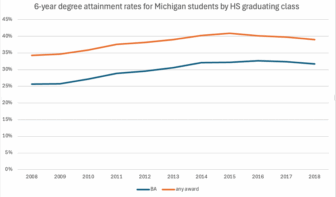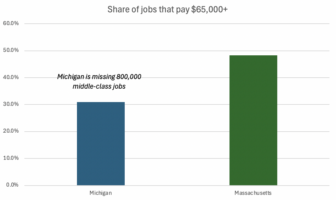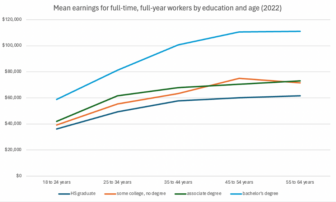This blog is authored by Wayne State University President Dr. M. Roy Wilson.
![]() I’m happy to have this opportunity to write about student success for Michigan Future, Inc. The success of Wayne State University students is my personal passion and the highest priority in our strategic plan.
I’m happy to have this opportunity to write about student success for Michigan Future, Inc. The success of Wayne State University students is my personal passion and the highest priority in our strategic plan.
One of the qualities that attracted me most to Wayne State University is the opportunity it affords a remarkable array of students. We welcome a broad spectrum of Michigan’s students—including many of the best, as well as many of its most socioeconomically disadvantaged. We do this because it is the right thing to do.
These students sometimes need extra support to cross the finish line, and to that end Wayne State makes it a priority to provide all students with the resources and tools they need to complete their education. In fact, we’ve invested more than $10 million in student success programs and initiatives over the past six years. And it’s starting to pay off in a big way.
One of our most important student success goals is improving the six-year graduation rate. As stated in our strategic plan, our goal is to increase this rate to 50 percent by 2021. For the past five years, our graduation rate has been improving two or three percentage points annually, a rate of improvement that put us in the top five percent of public colleges and universities nationally. This is outstanding progress, but it gets better.
Recently, we announced that the six-year graduation rate for the 2011 cohort is 47 percent, up eight percentage points from the 2010 cohort that graduated last year. We will likely meet our 50 percent goal next year, three years ahead of schedule.
We’re seeing similar gains across the board. Since 2011, WSU’s six-year graduation rate of African American students has tripled from 7 percent to 20 percent. Although we are not satisfied and there is significant room for improvement, we are pleased that other data indicate that continued improvement is coming. The first-to-second-year retention rates for black students is 70 percent, up from 57 percent in 2012.
And while it is true that the number of black students enrolled at WSU has declined over the past decade, the number of black students graduating each year has risen, from 426 eleven years ago to 585 in 2016.
These are all positive outcomes. But why is it so important these students graduate? Because a college degree is the key to social mobility in our democratic society.
A report published in the New York Times last March ranked more than 2,000 U.S. colleges and universities as engines of social mobility. In particular, the study revealed how well universities take students from lower-income households and propel them into the upper part of the wealth distribution.
When compared to other Michigan public universities, Wayne State was by far number one at mobility, coming in at 11.3 percent. (The mobility rate for other Michigan public universities ranged from 5.6 percent to 10.5 percent.) The report also revealed that Wayne State accepted a higher share of students from the lower 20 percent of the income scale than any other Michigan public university, and also had a higher share of students who moved up two or more quintiles than any other university in the state. Even when you stack up Wayne State against our peers nationally, we performed extremely favorably in this area.
For nearly 150 years, Wayne State has provided an excellent education and delivered on its promise of a better future. This mission drives us every day and will continue to fuel everything we do.
 Dr. M. Roy Wilson became the 12th president of Wayne State University on August 1, 2013. Prior to joining Wayne State, President Wilson served as deputy director for strategic scientific planning and program coordination at the National Institute on Minority Health and Health Disparities of the National Institutes of Health.
Dr. M. Roy Wilson became the 12th president of Wayne State University on August 1, 2013. Prior to joining Wayne State, President Wilson served as deputy director for strategic scientific planning and program coordination at the National Institute on Minority Health and Health Disparities of the National Institutes of Health.
Previously, he was dean of the School of Medicine and vice president for health sciences at Creighton University, president of the Texas Tech University Health Sciences Center, and concurrently, chancellor of the University of Colorado Denver and chair of the Board of Directors of University of Colorado Hospital. President Wilson also chaired the Board of Directors of the Charles R. Drew University of Medicine and Science and was acting president during part of that time.
President Wilson’s research has focused on glaucoma and blindness in populations from the Caribbean to West Africa. He is a member of the National Academy of Medicine (Institute of Medicine).
President Wilson received his undergraduate degree from Allegheny College, an M.S. in epidemiology from the University of California, Los Angeles, and an M.D. from Harvard Medical School.







